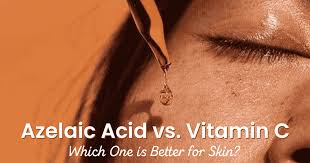
Can You Layer Vitamin C with Azelaic Acid? Here’s Everything You Need to Know
When it comes to skincare, vitamin C is a well-known hero. You’ve probably seen it in dozens of serums, moisturizers, and brightening creams. But what about azelaic acid?
This lesser-known yet powerful ingredient has been gaining popularity recently—and for good reason. Azelaic acid offers multiple benefits that make it a versatile choice for various skin types and concerns.
So, the big question is: Can you layer vitamin C with azelaic acid? The short answer is yes, but the long answer involves some key tips and best practices. Let’s break it all down.
What is Azelaic Acid?
Azelaic acid is a naturally occurring acid found in grains like barley, wheat, and rye. In skincare, it’s usually made synthetically to ensure stability and consistency.
It’s not an AHA or BHA, although people often confuse it with those exfoliating acids. Instead, it belongs to a class of ingredients known as dicarboxylic acids.
This acid is primarily used to treat acne and rosacea. It reduces inflammation, clears pores, and helps remove dead skin cells.
Azelaic acid also has antibacterial properties. This means it can target acne-causing bacteria while keeping your skin calm and balanced.
What makes azelaic acid stand out is its gentle nature. It exfoliates without irritating, making it suitable for sensitive or redness-prone skin.
It also tackles dark spots, post-acne scars, and uneven texture. Over time, skin looks brighter and feels smoother.
In short, it’s a multitasking powerhouse. From brightening to calming and clarifying, azelaic acid does it all.
What is Vitamin C?
Vitamin C, also known as ascorbic acid, is one of the most effective antioxidants in skincare. It’s a favorite for those wanting a glowing, even complexion.
It neutralizes free radicals, which are harmful molecules caused by sun damage, pollution, and daily stress. These free radicals can speed up signs of aging.
By using vitamin C regularly, you can prevent fine lines, dullness, and sunspots from forming.
It also boosts collagen production. This helps to firm the skin and reduce the appearance of wrinkles over time.
Vitamin C is also great for fading hyperpigmentation, acne scars, and discoloration. It leaves your skin looking clearer and more radiant.
Its brightening effect is why so many people include vitamin C in their morning routine. It gives skin a fresh, healthy glow all day long.
Can You Layer Vitamin C and Azelaic Acid?
Yes, you absolutely can. Vitamin C and azelaic acid both have powerful antioxidant and skin-enhancing benefits.
They each help to brighten skin, even tone, and fade pigmentation. Using them together can give you enhanced results.
However, it’s important to approach this combination with care. Both are active ingredients, so sensitive skin types should be cautious.
If you’re new to these actives, don’t jump into using them together right away. It’s best to introduce them slowly and monitor your skin’s reaction.
One safe method is to use vitamin C in the morning and azelaic acid at night. This helps reduce the risk of irritation while still getting the full benefits.
Doing this also allows each product to work more effectively, as your skin gets a chance to absorb the actives without competing layers.
If you have more resistant or balanced skin, you might be able to layer them directly. Just make sure to apply the thinner product first—usually vitamin C—then follow with azelaic acid.
Always finish with moisturizer and sunscreen during the day. This helps seal in the actives and protect your skin from UV damage.
What Can You Layer with Azelaic Acid?
Azelaic acid is incredibly versatile and pairs well with many other ingredients. Here are a few combos that work beautifully.
1. Azelaic Acid and Niacinamide
This duo helps reduce redness, fade dark spots, and calm inflammation. Niacinamide supports the skin barrier, while azelaic acid refines texture.
Together, they can improve signs of acne, rosacea, and dullness. These two are safe to use in the same routine—morning or evening.
2. Azelaic Acid with AHAs and BHAs
You can pair azelaic acid with chemical exfoliants like glycolic acid (AHA) or salicylic acid (BHA). But be cautious not to overdo it.
Too many exfoliants can lead to dryness, irritation, or a damaged skin barrier. Alternate days or use AHAs/BHAs at night and azelaic acid in the morning.
This way, your skin reaps the benefits without becoming overwhelmed.
3. Azelaic Acid and Vitamin C
As we discussed earlier, these ingredients can be a dream team when used wisely. Stick to applying one in the morning and the other at night, especially if your skin is sensitive.
Both ingredients promote glow, reduce pigmentation, and boost antioxidant protection. When used consistently, they deliver visible improvements.
What’s Better: Vitamin C or Azelaic Acid?
Both ingredients offer unique benefits. If we had to choose one for general use, vitamin C might take the lead.
That’s because vitamin C occurs naturally in the skin and offers universal benefits like collagen production and antioxidant protection.
But that doesn’t mean azelaic acid isn’t valuable. For those with acne, rosacea, or pigmentation issues, azelaic acid can be even more effective.
The good news? You don’t have to choose. Most people can safely use both with proper layering and patience.
Just make sure to patch test any new product before applying it to your face. Apply a small amount on your inner arm and wait 24 hours. If there’s no irritation, you’re good to go.
Can You Layer Other Acids with Vitamin C?
Yes, you can. But it requires some planning to avoid irritation and get the best results. Here are two approaches to try:
Option 1: Use Vitamin C and Acids at Different Times
This is the safer route for those with sensitive or dry skin. Apply vitamin C in the morning and reserve AHAs or BHAs for nighttime use.
This keeps your skin barrier healthy and maintains the natural pH level of your skin. It also minimizes the risk of reactions or over-exfoliation.
Option 2: Layer Vitamin C and Acids Together
If your skin is used to actives, you might try layering vitamin C with mild acids. Start slow, use low concentrations, and monitor how your skin responds.
Make sure to hydrate and moisturize well. Following up with sunscreen is non-negotiable, especially when using acids.
Final Thoughts
Layering vitamin C and azelaic acid can be a fantastic addition to your skincare routine. These two ingredients offer a wide range of benefits for all skin types.
From brightening to clearing and calming, this duo can transform your skin when used correctly.
Always start slow, listen to your skin, and be consistent. With time, you’ll see noticeable results—and a more radiant complexion.
If you’re ever unsure about how to combine actives, it’s wise to consult a dermatologist. Personalized advice is always the best choice.
And remember: Skincare is a journey, not a race. Be patient, stay informed, and your skin will thank you.


